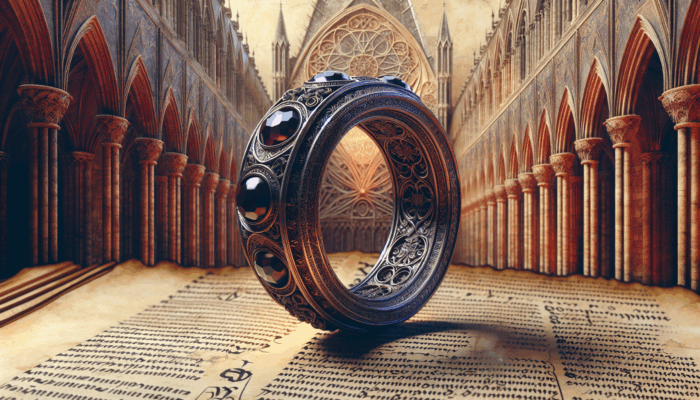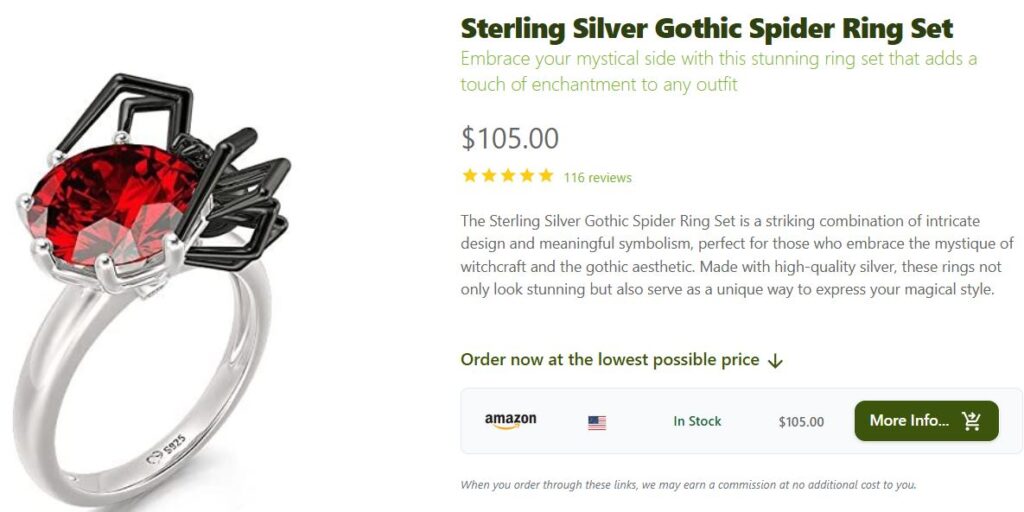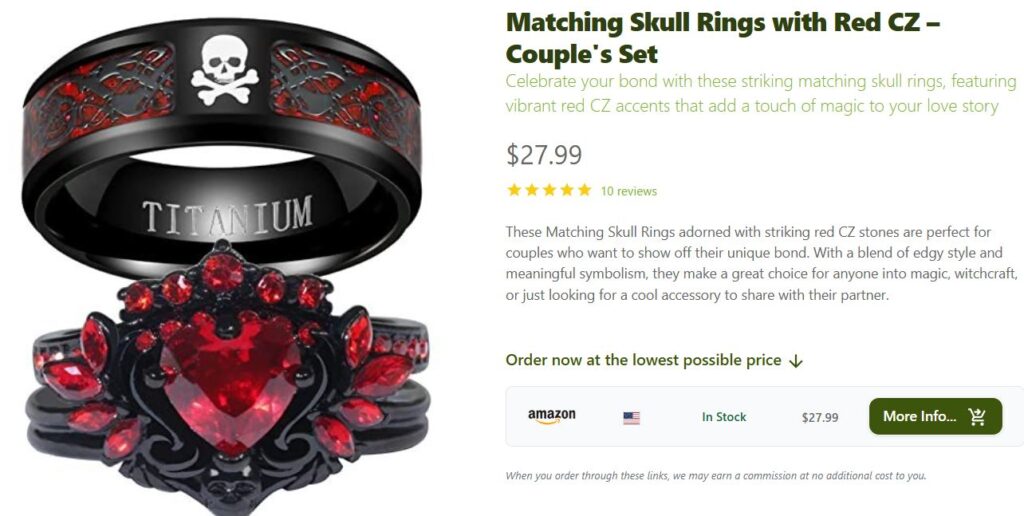Exploring the Rich History of Gothic Rings
Tracing the Origins of Gothic Rings
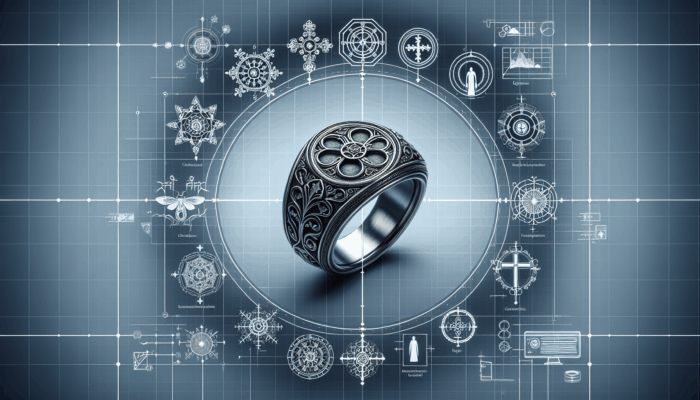
The captivating history of gothic rings is woven with intricate threads that originate from the medieval era, a time when these rings were not merely decorative items but also potent symbols of faith, status, and individual identity. The earliest forms of these rings can be traced back to the lavish jewelry adorned by the nobility and clergy, characterized by elaborate designs that mirrored the stunning Gothic architecture of their time. This period was marked by a harmonious blend of spirituality and artistry, creating breathtaking visual representations of divine and earthly connections.
As centuries progressed, the evolution of gothic rings reflected profound shifts in societal values. During the early medieval era, the predominant symbolism centered around religious devotion, often incorporating crosses and ecclesiastical motifs that served as tokens of faith. However, as we transitioned into the late medieval period, the Renaissance ushered in an era of individualism, prompting the incorporation of unique personal symbols like family crests or meaningful gemstones. This shift marked a significant transformation in the cultural narrative surrounding gothic rings, transforming them into powerful expressions of personal identity rather than mere religious artifacts.
By the Victorian era, gothic rings had undergone a remarkable transformation, becoming even more ornate and intricate, reflecting the period's fascination with the macabre and the mysterious. This era saw the rise of mourning rings, often embellished with symbols of death and remembrance, including skulls and weeping willows. This evolution not only illustrates how gothic rings have been shaped by the cultural contexts of their time but also highlights their enduring legacy, leading to the diverse range of designs we admire in contemporary gothic jewelry today.
The Cultural Importance of Gothic Rings
The cultural importance of gothic rings extends far beyond their visual appeal. Across various cultures, these rings have become essential symbols that encapsulate deep-seated beliefs, traditions, and individual identities. For instance, in medieval Europe, rings often served as signet rings used to seal important documents, thus establishing a powerful link between authority and adornment. These rings were more than ornamental; they were potent statements of social standing and personal faith, representing the intricate interplay between culture and jewelry.
In many Indigenous cultures, the symbols found in gothic rings resonate profoundly with spiritual beliefs and ancestral ties. Certain motifs, such as the serpent, embody duality, symbolizing both creation and destruction, as well as life and death. These interpretations provide a glimpse into how gothic rings can act as conduits for cultural storytelling, merging artistry with profound meaning. Importantly, the symbolism associated with these rings is dynamic, evolving over time to allow individuals to weave their own narratives into these powerful pieces of jewelry.
Throughout the world, gothic rings have been embraced by various subcultures, particularly within the goth community. For these individuals, these rings transcend mere accessories; they serve as vital expressions of identity, often used to challenge societal norms. Consequently, the significance of gothic rings transcends their decorative purpose, enabling wearers to showcase their uniqueness and foster a sense of belonging in a broader cultural dialogue.
Understanding the Evolution of Gothic Ring Designs
The evolution of gothic ring designs has been a remarkable journey, showcasing a blend of tradition and innovation. Initially rooted in religious motifs, modern designs have diversified to encompass a wide array of styles that authentically express personal beliefs and individuality. Classic gothic rings typically feature intricate metalwork, dark gemstones, and motifs such as crosses, skulls, and roses, all of which resonate with the aesthetics of Gothic architecture and art.
With the emergence of modern craftsmanship, designers have begun to experiment with unconventional shapes and materials, giving rise to fresh interpretations of traditional gothic styles. The incorporation of alternative materials, such as titanium and stainless steel, has not only enhanced the durability of these pieces but also introduced unique visual appeal. This contemporary approach caters to a wider audience, allowing enthusiasts to appreciate the gothic style without being confined to traditional designs.
Moreover, the influence of popular culture has significantly shaped the evolution of gothic rings. From iconic films to various music genres, gothic aesthetics have permeated mainstream consciousness, leading designers to infuse modern elements into their creations. This includes incorporating motifs from popular literature or movements that embrace individuality and rebellion. The cross-pollination of ideas ensures that gothic rings remain relevant, reflecting the evolving tastes and times of wearers around the globe.
Unpacking the Symbolism in Gothic Rings
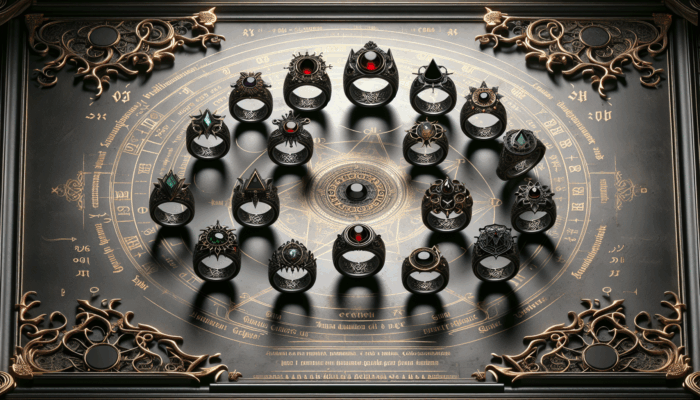
Exploring Common Symbols Found in Gothic Rings
Gothic rings are imbued with rich symbolism, with each motif carrying deep significance rooted in history and culture. Among the most prevalent symbols are skulls, crosses, and serpents, each evoking profound ideas about life, death, and spirituality. Skulls, for instance, are often linked to mortality, serving as poignant reminders of life’s transient nature. They embody not just an end but also a celebration of existence, urging individuals to embrace the present moment fully.
Crosses are perhaps the most recognizable symbols in gothic jewelry, representing faith and redemption. However, their significance has evolved over time; they can symbolize protection, hope, or even a rebellion against societal norms. The serpent, conversely, embodies themes of transformation and duality. In many cultures, serpents are revered as symbols of wisdom and renewal, often layered with meanings that reflect the complex narratives of the human experience.
These symbols resonate deeply with wearers, providing a means to express their personal beliefs and experiences. For many individuals, the choice of a gothic ring is a reflection of their journey, a way to carry their stories and values with them. Whether it’s a skull serving as a reminder of life’s fleeting nature or a cross symbolizing steadfast faith, these rings encapsulate personal philosophy, making each piece a unique artifact.
Personal Significance Behind Gothic Rings
While gothic rings are steeped in traditional symbolism, they also serve as powerful expressions of personal identity. Many wearers choose these distinctive pieces not just for their aesthetic allure but for the profound significance they encapsulate in their lives. The meanings attached to these rings can vary greatly, ranging from representing important milestones such as graduations or anniversaries, to commemorating loved ones who have passed away. The selection of specific symbols can transform a simple piece of jewelry into a cherished talisman filled with personal meaning.
For some, the act of personalizing gothic rings extends to engraving names, dates, or phrases that hold special significance. This practice imbues the ring with even greater sentimental value, forging a connection that transcends the material. Customizing a gothic ring allows individuals to link their beliefs, experiences, or aspirations, bridging the gap between the personal and the artistic.
Moreover, the journey of self-discovery often intertwines with the choice of gothic rings. Many individuals resonate with the deeper themes represented by gothic symbols—such as the eternal struggle between light and dark, love and loss, and transformation. By choosing to wear these symbolic pieces, they embrace their narratives, allowing the rings to become extensions of their identity while inviting others to explore the stories behind their unique choices.
Diverse Cultural Interpretations of Gothic Symbols
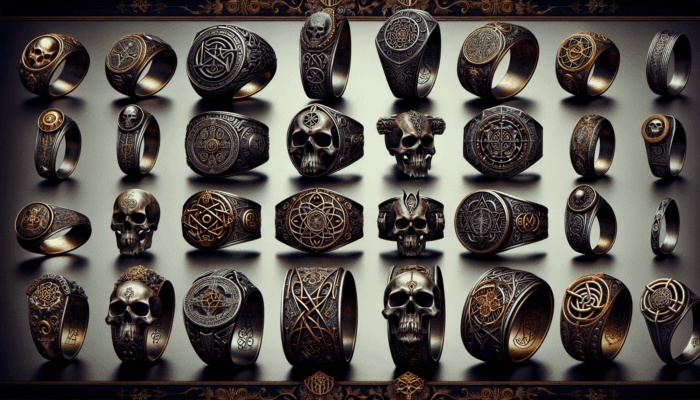
The interpretations of gothic ring symbols vary significantly across cultures, enriching the narrative surrounding these exquisite pieces. For instance, while a skull may signify mortality in one culture, it might represent strength and resilience in another. The diverse meanings attributed to similar symbols emphasize the complexity of human experience and belief systems. Understanding these cultural interpretations allows wearers to appreciate the depth of their gothic rings, connecting them to a broader human narrative.
In certain Indigenous cultures, for example, serpents are revered as symbols of transformation and renewal, playing significant roles in creation stories and spiritual practices. Conversely, in Western contexts, they may invoke fear or signify danger. This dichotomy illustrates how context shapes meaning, rendering gothic rings not just personal artifacts but also cultural commentaries that invite reflection.
Exploring these varying interpretations can yield insights into how different societies view concepts of life, death, faith, and individuality. As individuals wear gothic rings, they become part of a larger conversation about cultural identity and expression, breathing life into symbols that have stood the test of time. By embracing these diverse meanings, wearers can cultivate a deeper connection to their rings, enriching their experience and understanding of these beautiful artifacts.
Materials Commonly Used in Gothic Rings
Traditional Metals: Silver and Gold
When it comes to the creation of gothic rings with meaning, traditional metals such as silver and gold have played an essential role. Silver is a favored choice due to its malleability and lustrous appearance, making it an ideal medium for crafting intricate designs that capture the essence of gothic artistry. Its reflective quality adds a mysterious allure, enhancing pieces that explore themes of light and dark within gothic jewelry.
Gold, in contrast, symbolizes wealth and power, often signifying status in various cultures. The use of gold in gothic rings conveys a sense of elegance and prestige while simultaneously serving as a connection to heritage. Factors such as alloy composition can also influence the final product; for instance, rose gold has gained popularity for its warm hue, often resonating with romantic or nostalgic themes within gothic aesthetics.
Both metals can take on various finishes, from antiqued to polished, affecting the overall character of the ring. The choice of finish can dramatically alter its appearance, allowing for greater versatility in design. A matte, rough finish may evoke a sense of age and history, while a polished surface lends itself to a more contemporary look. This interplay between materials and finishes plays a crucial role in creating gothic rings that resonate with wearers on multiple levels, making each piece unique.
Exploring Modern Alternatives: Titanium and Stainless Steel
Contemporary gothic ring designs have embraced modern alternatives, such as titanium and stainless steel, which offer unique attributes appealing to a broader audience. Titanium, known for its strength and lightweight properties, is increasingly favored by those who lead active lifestyles while still wishing to maintain their gothic aesthetic. Its natural silver-gray hue can be finished in various ways, allowing for a wide range of creative design possibilities.
Stainless steel is another modern material that has gained traction within the gothic jewelry scene. Its corrosion resistance and durability make it ideal for daily wear, appealing to those who desire a blend of style and practicality. Additionally, stainless steel can be easily manipulated to mimic traditional gothic motifs, allowing artisans to create striking designs that resonate with contemporary tastes and preferences.
These modern materials often come with the added benefit of affordability, making gothic rings more accessible to a larger audience. As designers experiment with these alternatives, they continue to push the boundaries of what gothic jewelry can represent, merging tradition with innovation while preserving the core essence of gothic aesthetics.
Enhancing Gothic Rings with Gemstones and Enamel
The incorporation of gemstones and enamel into gothic rings elevates both their aesthetic and symbolic value. Gemstones like onyx, garnet, and amethyst are commonly utilized for their deep, rich colors, which beautifully complement the darker themes often associated with gothic jewelry. Each gemstone carries its unique meanings; for example, garnet symbolizes love and passion, while amethyst is linked to clarity and tranquility. By selecting specific stones, wearers can imbue their rings with personal significance that extends beyond mere ornamentation.
Enamel is another fascinating material that allows for vibrant expression in gothic ring designs. With its ability to add intricate patterns and vivid colors, enamel can transform a simple metal band into a captivating visual masterpiece. This technique offers designers the opportunity to tell stories through color, enriching the narrative embedded within gothic rings. The use of dark, moody hues combined with vibrant accents creates a striking contrast, drawing attention and inviting curiosity.
The fusion of gemstones and enamel in gothic rings is not merely about visual appeal; it also reflects the contemporary trend of mixing materials to create unique, layered designs. This combination often results in rings that are not only beautiful but also rich in meaning, allowing wearers to express their individuality and personal narratives through their jewelry choices.
Exploring Unique Textures: Bone and Resin in Gothic Rings
The use of unconventional materials like bone and resin in gothic rings adds a distinctive texture and aesthetic that sets these pieces apart from traditional designs. Bone, often sourced ethically, can be intricately carved to create stunning designs that reflect the organic beauty of nature. The natural variations in color and texture make each ring a one-of-a-kind statement piece, resonating with those who appreciate the artistry of craftsmanship and the allure of the natural world.
Resin, on the other hand, opens up a world of creative possibilities. Designers can craft rings that encapsulate various elements, such as flowers, crystals, or even intricate patterns, allowing for a fusion of styles and themes. The ability to customize resin rings further enhances their appeal, making them particularly popular among individuals seeking distinctive gothic jewelry that stands out from the crowd.
Both bone and resin contribute a tactile quality to gothic rings, inviting touch and interaction. This aspect of design is crucial in creating pieces that are not just worn but experienced. As the gothic aesthetic continues to evolve, the integration of these unconventional materials ensures that the genre remains fresh and relevant, appealing to a diverse audience worldwide.
Adding Flair with Leather and Fabric
Incorporating leather and fabric elements into gothic rings adds a distinctive flair and comfort, setting these pieces apart within the realm of gothic jewelry. Leather, with its natural texture and durability, offers an alternative to traditional metal bands, providing a more bohemian and rustic appeal. Leather rings can be adorned with metal accents or embellishments, creating a striking juxtaposition between soft and hard materials that enhances their visual impact.
Fabric rings, often crafted from textiles like velvet or lace, introduce an element of softness and delicacy to the gothic aesthetic. These rings can feature intricate stitching, embroidery, or even be embellished with beads and charms, allowing for an explosion of creativity and artistic expression. The tactile nature of fabric invites more vibrant colors and patterns, appealing to those who wish to express their gothic style in a fashion-forward manner.
Both leather and fabric rings can particularly appeal to individuals seeking comfort in their jewelry. Unlike traditional metal rings, which might feel restrictive, these materials often provide a more flexible fit. The fusion of comfort, creativity, and gothic aesthetics invites wearers to explore a new dimension of self-expression, encouraging them to embrace their individuality in a diverse world.
Diverse Styles of Gothic Rings
Embracing Classic Gothic Styles
The allure of classic gothic rings lies in their timeless designs that echo the essence of a past era. These rings often feature ornate metalwork, dark gemstones, and motifs deeply rooted in medieval symbolism, such as crosses, skulls, and roses. The intricate craftsmanship involved in creating classic gothic rings is a testament to the artistry of jewelers who dedicate themselves to preserving traditional techniques and styles.
Classic gothic rings typically balance elegance and darkness, creating pieces that are both striking and meaningful. The use of black or deep red gemstones often enhances the overall aesthetic, while detailed engravings add layers of complexity to the design. These rings transcend mere fashion statements; they embody a rich history and cultural significance that resonates with wearers who appreciate the depth of their artistry and the stories they tell.
Moreover, classic gothic rings often evoke a sense of nostalgia, connecting wearers to a time when craftsmanship was paramount. As we navigate a world increasingly dominated by mass production, these rings stand out as reminders of the beauty that comes from handmade artistry. For those drawn to the gothic aesthetic, classic designs provide a sense of connection to heritage, tradition, and the narratives that have shaped the gothic style over centuries.
Contemporary Gothic Designs: A Modern Twist
Contemporary gothic rings represent a fresh interpretation of traditional aesthetics, blending modern design elements with classic motifs. These rings often feature innovative shapes and materials, such as sleek lines, asymmetrical designs, and alternative metals like titanium and stainless steel. This modern approach appeals to a diverse audience, inviting individuals to embrace gothic style without being constrained by traditional norms.
In contemporary gothic jewelry, creativity knows no bounds. Designers often experiment with unconventional forms and layering techniques, resulting in unique pieces that make bold statements. The use of vibrant colors through enamel or gemstones adds a contemporary twist, allowing wearers to explore the expressive potential of gothic aesthetics in innovative ways. This fusion of traditional symbols with modern design sensibilities ensures that gothic rings remain relevant in today’s fashion landscape, appealing to those who seek individuality.
The influence of popular culture is also palpable in contemporary gothic rings, as they frequently draw inspiration from literature, art, and music that celebrate the ethereal and the darkly beautiful. This connection to modern narratives allows wearers to engage with broader cultural dialogues, making their gothic rings not just accessories, but essential components of their personal style statements.
Subcultural Influences on Gothic Ring Styles
The styles of gothic rings have been heavily influenced by various subcultures, each contributing unique elements to the gothic aesthetic. From the punk movement to the darkwave scene, these subcultures have embraced gothic jewelry as a means of self-expression, often incorporating societal critiques and personal narratives into their designs. As a result, the gothic ring has evolved to reflect a diverse array of influences, appealing to individuals from all walks of life.
For instance, punk-inspired gothic rings often feature spikes, studs, and unconventional materials, exuding a sense of rebellion and individuality. These designs challenge societal norms, allowing wearers to express their dissatisfaction with the status quo through their jewelry choices. Conversely, the darkwave scene often emphasizes romanticism and melancholy, leading to rings that incorporate softer elements, such as lace or delicate metalwork.
The blending of subcultural influences has also led to the emergence of hybrid styles that fuse gothic aesthetics with other genres. For example, steampunk gothic rings may feature gears and clockwork elements intertwined with traditional gothic motifs, creating a unique juxtaposition that celebrates both the past and the future. These diverse influences ensure that gothic rings remain dynamic and relevant, continually reflecting the evolving landscape of personal expression and cultural identity.
Historical Gothic Designs: A Nod to the Past
Exploring historical gothic ring designs reveals a captivating narrative that draws inspiration from various periods, such as the Victorian era and the Middle Ages. These rings often embody the intricate details and rich symbolism characteristic of their time, providing wearers with a tangible connection to history. The resurgence of interest in historical gothic aesthetics has resulted in a renewed appreciation for these classic designs, allowing individuals to connect with the artistry of past eras.
Victorian gothic rings were particularly ornate, featuring intricate metalwork, dark gemstones, and motifs inspired by the macabre. Mourning rings, in particular, gained popularity during this era, serving as tokens of remembrance for lost loved ones. These rings often incorporated symbols like skulls or weeping willows, reflecting the era's fascination with death and the afterlife. As wearers adorned themselves with these pieces, they carried the weight of love and loss, making each ring a deeply personal artifact intertwined with emotion and memory.
The intricacies of Middle Ages gothic rings also stand out, characterized by their religious motifs and elaborate craftsmanship. These pieces frequently served as symbols of faith, adorned with crosses and sacred symbols that captured the spiritual fervor of the period. The detailed designs reflect a rich heritage of belief and devotion, inviting wearers to connect with the stories of those who came before them. The beautiful artistry captured in these rings transcends time, offering a bridge between history and contemporary style.
Guidelines for Choosing the Perfect Gothic Ring
Identifying Your Personal Style
Selecting the perfect gothic ring with meaning begins with a journey of self-discovery, allowing you to explore your personal style. It is essential to identify which aspects of gothic aesthetics resonate most with you. Are you attracted to darker motifs such as skulls and serpents, or do you lean toward more romantic elements like roses and crosses? Understanding your preferences will guide you toward finding a ring that reflects your unique individuality and personal taste.
Consider your overall wardrobe and how a gothic ring can complement your style. A classic gothic ring might pair beautifully with a vintage-inspired outfit, while a contemporary piece could align better with modern streetwear. Emphasizing the ring's design elements that resonate with you—such as intricate metalwork or vibrant gemstones—will help ensure it becomes a cherished part of your collection.
Additionally, think about how you want to wear the ring. Are you looking for a statement piece for special occasions, or do you desire something versatile enough for daily use? The intended purpose of the ring can significantly influence your choice, guiding you toward styles that align with your lifestyle and aesthetic preferences.
Considering the Occasion and Usage
When choosing gothic rings, it is crucial to consider the occasion and how you plan to wear them. Some rings may be best suited for special events, while others are designed for everyday wear. Understanding the context in which you'll be wearing the ring can significantly influence your choice and enhance your overall experience.
For formal occasions, consider gothic rings that feature elegant designs and high-quality materials. Intricate details and classic motifs can elevate your outfit and create a bold statement. Conversely, for casual wear, you may prefer simpler designs that offer comfort and versatility without sacrificing style.
Moreover, consider how often you plan to wear the ring. If it's intended for daily use, opt for durable materials like stainless steel or titanium that can withstand the rigors of everyday life. A well-crafted gothic ring should not only be visually stunning but also functional, ensuring it can accompany you on your everyday adventures with ease and grace.
Budgeting for Your Gothic Ring Purchase
Finding high-quality gothic rings with meaning that fit your budget is entirely achievable with some research and creativity. Gothic jewelry can range widely in price, from affordable fashion pieces to high-end artisan creations. Knowing your budget upfront will help narrow down your options and prevent overspending, allowing you to focus on pieces that truly resonate with you.
For those on a tighter budget, consider exploring alternative materials such as resin or stainless steel, which often offer unique designs at lower price points. Vintage shops and artisan markets can also be treasure troves for discovering distinctive gothic rings that won’t strain your finances while still allowing you to express your style.
If your budget permits higher-end purchases, investing in pieces crafted from precious metals and adorned with genuine gemstones can be worthwhile. These rings not only elevate your style but may also appreciate in value over time, making them a potential investment. Ultimately, it’s about finding the right balance between style, quality, and affordability that aligns with your personal values.
Essential Care Tips for Gothic Rings
Effective Cleaning Techniques
Maintaining the beauty of gothic rings with meaning requires adopting proper cleaning techniques to keep them looking their best. Regular cleaning is essential to remove dirt and oils that can accumulate over time, dulling the ring's appearance and detracting from its beauty. For metal rings, a gentle solution of warm water and mild soap is often sufficient. Utilize a soft cloth or a toothbrush with soft bristles to gently scrub the surface, paying special attention to intricate details and engravings that may require extra care.
For gemstone-adorned rings, it’s vital to consider the type of stone when cleaning, as some gemstones may be more delicate and require specific care. Always research the best cleaning methods for your particular stones to prevent damage. After cleaning, ensure that the ring is thoroughly dried to prevent moisture buildup, which can lead to tarnishing and other forms of deterioration over time.
Consider using a jewelry polishing cloth designed for the specific metals in your gothic rings. These cloths can help restore shine and remove tarnish without causing scratches or damage. Establishing a regular cleaning routine will not only preserve the beauty of your gothic rings but also prolong their lifespan, allowing you to enjoy their symbolic meanings for years to come.
Smart Storage Solutions
Proper storage is essential for protecting gothic rings with meaning from damage and tarnish when not in use. Avoid tossing them into a jewelry box haphazardly, as this can lead to scratches and tangled chains. Instead, consider investing in a dedicated jewelry organizer or individual pouches to keep your rings safe and secure while minimizing the risk of damage.
Storing rings separately can help prevent them from scratching each other, maintaining their pristine condition. For metal rings, consider using anti-tarnish pouches or cloths, which inhibit tarnishing reactions and preserve their shine. Additionally, keeping rings away from direct sunlight and humidity can help maintain their integrity over time, ensuring they remain beautiful for years to come.
When traveling, it’s wise to use a travel case that securely holds each ring in place, minimizing movement that could cause damage. By prioritizing proper storage, you can ensure that your gothic rings remain in excellent condition, ready to be worn whenever the mood strikes or the occasion arises.
Repair and Maintenance Essentials
Over time, even the most well-cared-for gothic rings with meaning may require repair or maintenance. Understanding when to seek professional help is crucial for preserving the integrity of these cherished pieces. Signs of wear and tear, such as loose settings or scratches, should be addressed promptly to prevent further damage and ensure the longevity of your jewelry.
Many jewelers offer repair services for gothic rings, ranging from stone resetting to polishing and refinishing. If your ring features intricate designs or delicate gemstones, it’s wise to consult with a professional who specializes in gothic jewelry. Their expertise will ensure that repairs are conducted with care, preserving the ring's unique character and meaning while restoring its beauty.
Regular maintenance can also help prolong the life of your gothic rings. Periodically check for any loose stones or signs of wear, and don’t hesitate to bring them to a jeweler for a thorough inspection. Investing in professional care will ensure your gothic rings remain beautiful, meaningful, and cherished for generations to come.
Gothic Rings in the Fashion World
Gothic Rings on the Runway: A Fashion Statement
Gothic rings with meaning have made a significant impact on fashion runways worldwide, showcasing their versatility and appeal. Designers are increasingly incorporating gothic elements into their collections, allowing these rings to become key accessories that enhance the overall aesthetic of their outfits. From high-end couture to street fashion, gothic rings are taking center stage, proving that they can transcend traditional boundaries while remaining fashionable.
Runway trends often feature intricate designs, bold motifs, and a mix of materials, reflecting the diverse interpretations of gothic style. Influential fashion houses have embraced gothic aesthetics, showcasing rings adorned with symbolism that resonates with contemporary themes. This blending of high fashion and gothic elements allows wearers to express their individuality while embracing the allure of the gothic narrative.
As gothic rings continue to appear in fashion shows, they inspire new trends and styles, inviting designers and consumers alike to explore the depths of the gothic aesthetic. This fusion of runway flair with personal expression ensures that gothic rings remain not just fashionable accessories, but also meaningful artifacts of self-identity that enrich the world of fashion.
The Celebrity Influence on Gothic Rings
The impact of celebrities on the popularity of gothic rings with meaning cannot be overstated. High-profile figures often choose to wear these distinctive pieces, drawing attention to their unique styles and shaping public perception of gothic aesthetics. From musicians to actors, many celebrities have embraced gothic rings as essential components of their personal branding, showcasing how these accessories can convey individual narratives and cultural significance.
Celebrities have a way of making gothic rings mainstream, influencing trends and encouraging fans to explore the gothic aesthetic themselves. This visibility has led to an increased demand for gothic jewelry, prompting designers to create new and innovative designs that cater to the evolving tastes of consumers. The presence of gothic rings on red carpets and in music videos has cemented their status as fashionable statements, inviting a wider audience to connect with the rich symbolism embedded in these exquisite pieces.
By wearing gothic rings, celebrities not only showcase their style but also encourage discussions around themes like identity, self-expression, and cultural narratives. This cultural influence plays a significant role in shaping how gothic rings are perceived and appreciated in modern fashion, further elevating their status within the industry.
Incorporating Gothic Rings into Everyday Fashion
Integrating gothic rings with meaning into everyday fashion is a delightful way to express personal style while embracing the gothic aesthetic. These rings can effortlessly enhance any outfit, whether you’re dressing for work, a casual outing, or a night out on the town. The versatility of gothic rings allows them to be paired with various styles, from bohemian to edgy, enabling you to curate a look that resonates with your individuality and personal flair.
When wearing gothic rings daily, opt for designs that balance aesthetic appeal with comfort. Simple, understated rings can work well for everyday wear, while more elaborate statement pieces can be reserved for special occasions. Mixing and matching rings with different materials and styles can create a unique layered look that genuinely showcases your personality.
Consider how gothic rings can complement other accessories to create cohesive outfits. Pairing them with leather jackets, lace tops, or even denim can create visually striking ensembles that embody the gothic spirit. By incorporating gothic rings into your everyday wardrobe, you maintain a connection to the deeper meanings they hold while celebrating your unique sense of style and self-expression.
The Art of Collecting Gothic Rings
Strategies for Building a Gothic Ring Collection
Starting and growing a collection of gothic rings with meaning can be an exhilarating journey for any jewelry enthusiast. To build a diverse collection, begin by identifying your personal style and the elements that resonate with you. This foundational knowledge will guide your purchasing decisions, ensuring your collection remains cohesive and meaningful as you explore the world of gothic jewelry.
Exploring different styles, materials, and designs is essential for expanding your collection. Attend craft fairs, vintage markets, and local artisan shops to discover unique gothic rings that may not be available in mainstream stores. Online platforms also offer a vast array of options, connecting you with designers and artisans from around the globe, further enriching your collection with diverse influences and styles.
As you build your collection, consider documenting your journey. Keep a record of each ring's history, including when and where you acquired it and any personal meanings attached to it. This documentation adds depth to your collection and serves as a valuable resource for sharing your passion with others. Collecting gothic rings is not just about amassing jewelry; it’s about curating a narrative that reflects your tastes and experiences in the world of gothic aesthetics.
Discovering Rare and Unique Gothic Rings
For avid collectors of gothic rings with meaning, the thrill of discovering rare and unique pieces can be an exhilarating experience. Many collectors are drawn to one-of-a-kind designs that tell a story, whether through intricate craftsmanship, unusual materials, or historical significance. To uncover these hidden gems, it’s essential to explore various avenues and avenues.
Antique shops and estate sales can serve as treasure troves for finding distinctive gothic rings that carry a sense of history and character. Similarly, artisan markets often feature local craftsmen who create exceptional pieces, allowing you to connect with designers and understand the stories behind their work. Online platforms also provide opportunities to discover rare finds, with many artisans offering limited-edition collections or bespoke designs tailored to unique tastes.
Networking within the gothic community can also lead to the discovery of unique pieces. Engaging with fellow enthusiasts, attending events, and participating in online forums can open doors to exclusive collections or trade opportunities. The joy of uncovering rare gothic rings not only adds value to your collection but also fosters connections within a vibrant community of like-minded individuals passionate about gothic aesthetics.
Understanding the Investment Value of Gothic Rings
Understanding the potential investment value of certain gothic rings with meaning is an important consideration for collectors. While many pieces serve as fashion statements, some can appreciate in value over time, making them worthwhile investments. Factors that contribute to a ring’s investment potential include the quality of materials, craftsmanship, and historical significance.
Rings crafted from precious metals and adorned with genuine gemstones often hold greater value, especially if they feature intricate designs or unique symbols. Additionally, pieces created by renowned designers or those associated with significant cultural movements can increase in prominence as demand for gothic jewelry continues to grow.
As you consider building an investment-worthy collection, conduct thorough research on market trends and value assessments to make informed decisions. By acquiring pieces with both personal and investment value, you can enjoy the beauty and meaning they hold while also nurturing a collection that may yield financial returns in the future, allowing you to appreciate gothic jewelry on multiple levels.
Frequently Asked Questions About Gothic Rings
What defines gothic rings with meaning?
Gothic rings with meaning are jewelry pieces that incorporate dark, intricate designs and symbolism, often reflecting themes of spirituality, individuality, and personal beliefs. They are crafted from various materials and commonly feature motifs like skulls, crosses, and serpents, each carrying its own significance.
How can I choose the right gothic ring for my style?
Choosing the right gothic ring involves considering your personal style, the occasion, and your budget. Identify which motifs resonate with you, and select a ring that complements your wardrobe while aligning with your aesthetic preferences and individual expression.
Are gothic rings suitable for everyday wear?
Yes, many gothic rings are designed for daily wear, especially those made from durable materials like stainless steel or titanium. Opt for simpler designs for everyday use, while reserving more elaborate pieces for special occasions or significant events.
What are the best practices for cleaning and maintaining gothic rings?
To clean gothic rings, use a gentle solution of warm water and mild soap, along with a soft cloth or brush. Regular maintenance, such as checking for loose stones and ensuring proper storage, will help preserve their beauty and longevity.
Do celebrities wear gothic rings?
Absolutely! Many celebrities wear gothic rings, showcasing them as fashionable accessories that also convey personal narratives and cultural significance, helping to elevate their status within contemporary fashion.
What materials are commonly used in gothic rings?
Common materials for gothic rings include traditional metals such as silver and gold, modern alternatives like titanium and stainless steel, and unique elements such as gemstones, enamel, bone, and resin.
What symbols are often found on gothic rings?
Popular symbols on gothic rings include skulls, crosses, and serpents, each carrying significant meanings related to life, death, spirituality, and individual beliefs and experiences.
How can I ensure my gothic ring is a good investment?
To ensure your gothic ring is a good investment, focus on pieces made from high-quality materials, with intricate craftsmanship and historical significance, while staying informed about market trends and value assessments.
Where can I find unique and rare gothic rings?
Unique and rare gothic rings can be discovered in antique shops, artisan markets, online platforms, and through networking within the gothic community, where collectors often share leads on exceptional pieces.
What is the significance of wearing a gothic ring?
Wearing a gothic ring allows individuals to express their personal style and beliefs while connecting to the rich history and symbolism associated with gothic culture, making it a meaningful accessory that reflects one's identity.

